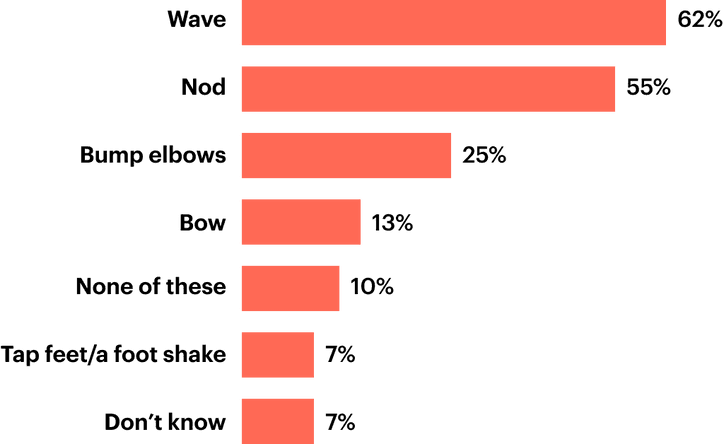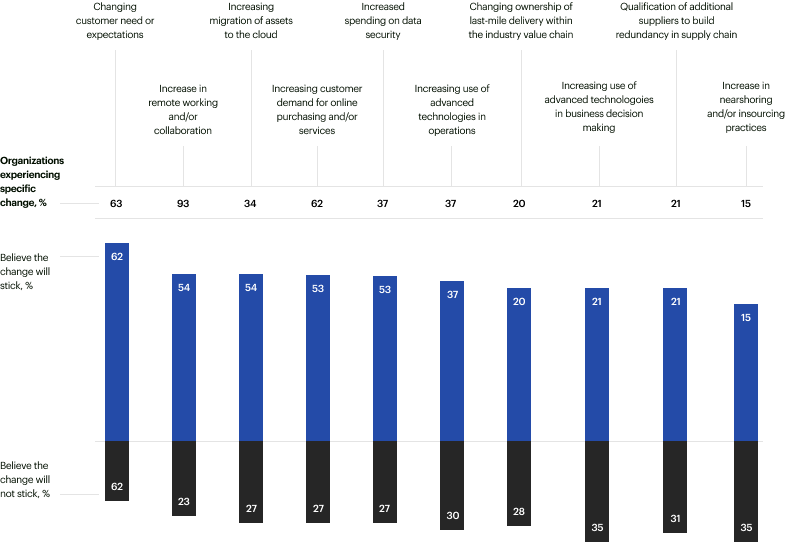Growing the Distance: the Need for Human Touch
Since the pandemic started, our lives have made a shift we couldn’t imagine in 2020. Months of social distancing, obeying Covid-19 restrictions, and trying to adapt to the ever-changing new normal have left their mark on us all. Most of our lives have transitioned online and whatever out-of-home activities we have now rarely involve close interaction with others. How exactly did quarantine and self-isolation affect the way we communicate with people and businesses? What new habits and demands have formed? How can brands cater to the customer needs in the ever-changing “new normal”?
Customer expectations to increase touchless interactions with organizations during vs post-Covid-19, by country*

The Quarantine Effect
Apart from the overall uncertainty looming over us, the pandemic has also separated people from friends, neighbors, co-workers - and offline businesses.
Life transitioning online
In May 2020, some 31 percent of US respondents said that they had deliberately bought food or restaurant takeaway online instead of offline due to the pandemic. Indeed, during the pandemic digital adoption has taken a quantum leap. According to a survey by McKinsey, customers “are three times likelier now than before the crisis to say that at least 80 percent of their customer interactions are digital in nature.”
Workplaces going remote
Before the Covid outbreak, in early 2020 there were already 7 million people working remotely in the US, making it 3.4 percent of the population. According to a new survey, the number of employees permanently working remotely globally is expected to double in 2021, rising from 16.4% to 34.4%.
Rising stress and anxiety
In a survey by mental health provider Ginger, nearly 7 in 10 employees named the Covid-19 pandemic the most stressful time of their entire professional career. This has aligned with dramatic increases in new prescriptions of antidepressant, antianxiety, and anti-insomnia medications.
Avoiding physical contact
With Covid prevention measures in place, people increasingly opt for non-tactile greetings as well as look for digital, touchless interactions with organizations. According to Statista, even post-pandemic customers across the world will continue to use touchless interfaces.

Research says, social deprivation and lack of human interaction are associated with increased hormone levels, high blood pressure, sleeplessness, anxiety, and depression. No wonder, top 10 mental wellness apps including Calm and Headspace accumulated up to 10 million downloads in April 2020, which is a 24.2-percent-increase from the installs they generated in January 2020.
What do Customers Expect?
The pandemic has changed the way people work, shop, and communicate - most of that now happens online. Thus, the number of customers shopping for food and household items has increased by 30 percent. So, to deliver, businesses will need to focus on several things.
Availability across multiple channels
The shift to digital raises customer demands even higher: they want to be able to reach businesses 24/7 and the way it is more convenient for them. So brands need to become truly omnichannel.
Health safety in public spaces
In the next couple of years, people will be reluctant to touch surfaces in public places. Those offline businesses that survive will need to think beyond the touch interfaces.
Security everywhere
With our lives increasingly dependent on our devices, security is as important as ever. So biometric authentication is quickly becoming the norm for increased security.
Across business areas, the largest leap in digitization in the share of offerings that are digital in nature

Average share of products and services that are partially or fully digitized, %
How do Brands Adapt?
The largest shifts during the crisis are also among the most likely to stick through the recovery
Share of respondents, %

AI for availability
Transition into online has increased contact center load, so to become closer to their customers, brands need to become genuinely omnichannel online. However, it will require an army of human agents to timely address customer queries across many channels. That’s where AI-powered assistants come into play - they can quickly respond to simple questions and transfer more complex tasks to human agents.
Contactless interfaces
The aftermath of social distancing will linger, as institutions will introduce more options for self-service to avoid lines and crowds. Since surfaces in public places pose a real danger, those automatic services are likely to offer alternate interfaces like voice-powered or holographic screens. Moreover, venue owners are likely to start addressing this issue to stop the coronavirus from spreading - just like with “not touch” holographic elevator buttons in China. So, we are sure to see more technologies that allow for “no-touch” interfaces being adopted. There will be more voice-powered devices in public places: from elevators to self-service cash registers to public restrooms. This, in turn, will force speech recognition software providers to work harder on noise reduction.
Extended reality
Deprived of touch, businesses may turn to extended reality (XR) to create immersive experiences. This industry, comprising augmented reality, virtual reality, and mixed reality received over $4.1 billion of investment in 2019 from the likes of Apple and Facebook. For example, in the summer of 2020 retailers like Adidas and Macy’s launched virtual fitting rooms to enable customers to try on clothes before buying them online.
Sensory marketing
With limited offline presence, brands need to look for other ways to “touch” their customers. Dove made a go for aural marketing and partnered with Pandora to launch the Tropical Moods SoundEscape. This audio-guided experience features tropics-inspired music and sounds (birds chirping, soft rain falling djembe) that Dove customers can relax in the shower to. While Nike turned to scent marketing in collaboration with olfactive branding firm 12.29 to create a scent identity.
Smart devices
Tech giants helped users stay connected at home in their way, releasing smart displays like Facebook’s Portal, Google’s Nest Hub, and Amazon’s Echo Show. At the same time, quarantine boosted smart speaker usage among U.S. adults. As a result, many brands embraced the trend and started creating content for smart displays and smart speakers - from voice-interactive storybooks by Jim Henson Company, to culinary shows to health services.
While nothing can fully replace face-to-face interactions, brands can add “a human touch” to the customer experience they provide, and become increasingly available even in the ever-changing new realities.
